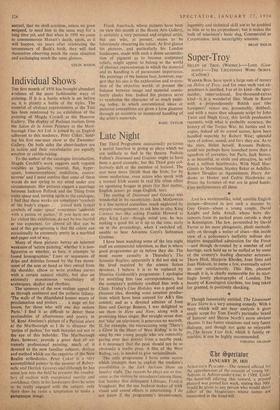Individual Shows
THE first month of 1956 has brought abundant evidence of the most fashionable ways of
painting. If it is a battle which is set before us, it is plainly a battle of the styles. The roomful of abstract expressionists at the Tate
has been reinforced by an exhibition of the painting of Magda Cordell at the Hanover Gallery. The display of Parisian realism from the Salon de la Jeune Peinture at the Marl- borough Fine Art Ltd. is joined by an English adherent to this tendency, Peter Coker, hold- ing his first one-man show at the Zwemmer Gallery. On both sides the cheer-leaders are in 'action and their vocabularies are equally emotive or rabble-raising.
To the author of the catalogue introduction, Magda Cordell's work suggests such voguish vocables as 'galactic, visceral, flux, hyper- space, homeomorphism; multiform, contra- terrene' and 1 must confess that some of these words do not spring to my mind under any circumstances. Her pictures suggest a marriage between Jackson Pollock and the Thing-from outer space and, turning again to the catalogue, I find that these works are sometimes 'symbols of the body's organs . . . joined with lyrical symbols of outer space' sometimes 'androids with a patina of pathos.' If you have not so far visited this exhibition, do not he too fearful or too expectant, for almost all that can be said of this gut-spinning is that the colour can occasionally be extremely pretty in a marbled end-paper sort of way.
Many of these pictures betray an inherent weakness of 'action painting,' whether it is non- figurative or whether, as here, it attempts `to found iconographies.' Lines or sequences of drips and dribbles formed by the free move- ment of the arm or hand as they swivel from the shoulder, elbow or wrist produce curves with a certain natural vitality, but also an extremely monotonous vocabulary of arabesques, shades and rhythms.
The sponsors of the new realism appeal to us through sentiment and the pathetic fallacy. 'The walls of the dilapidated houses weary of proclamation and posters . . . a stage set for lovers, for those who will one day restore Paris.' I find it as difficult to detect these profundities of allusiveness and poetry in M. Rena Aberlenc's picture of a Parisian place at the Marlborough as I do to discover the 'patina of pathos,' for such beauties are not in the eye of this beholder. The Marlborough does, however, provide a great deal of ex- tremely professional painting, much of it devoted to the now familiar subjects, devices and method which are the requisite of the New Realist orthodoxies. Peter Coker is a very accomplished painter in the manner of Rebey- rolle and Derrick Greaves and although he has come late into the field he presents the vocabu- lary of realism with exceptional suavity and confidence. Only in his landscapes does he seem to he really engaged with the subject; only there does he resist a temptation to make a picturesque image.
Frank Auerbach, whose pictures have been on view this month at the Beaux Arts Gallery, is certainly a very personal and original artist, but one who, at present, seems to be laboriously obscuring his talent. At first glance his pictures, and particularly his London landscapes, made with such a dense accumula- tion of pigment as to become sculptured reliefs, might appear to belong to the world of abstract expressionism in which the material and its handling is of paramount importance. His paintings of the human face, however, sug- gest that his aim is the exploration and re-crea- tion of the objective world; at present the balance between image and material consis- tently eludes him. Indeed his pictures serve to symbolise the character of so much paint- ing today, in which conventional ideas or pictorial conceptions arc given a false glamour through an eccentric or mannered handling of the artist's materials.
BASIL TAYLOR










































 Previous page
Previous page